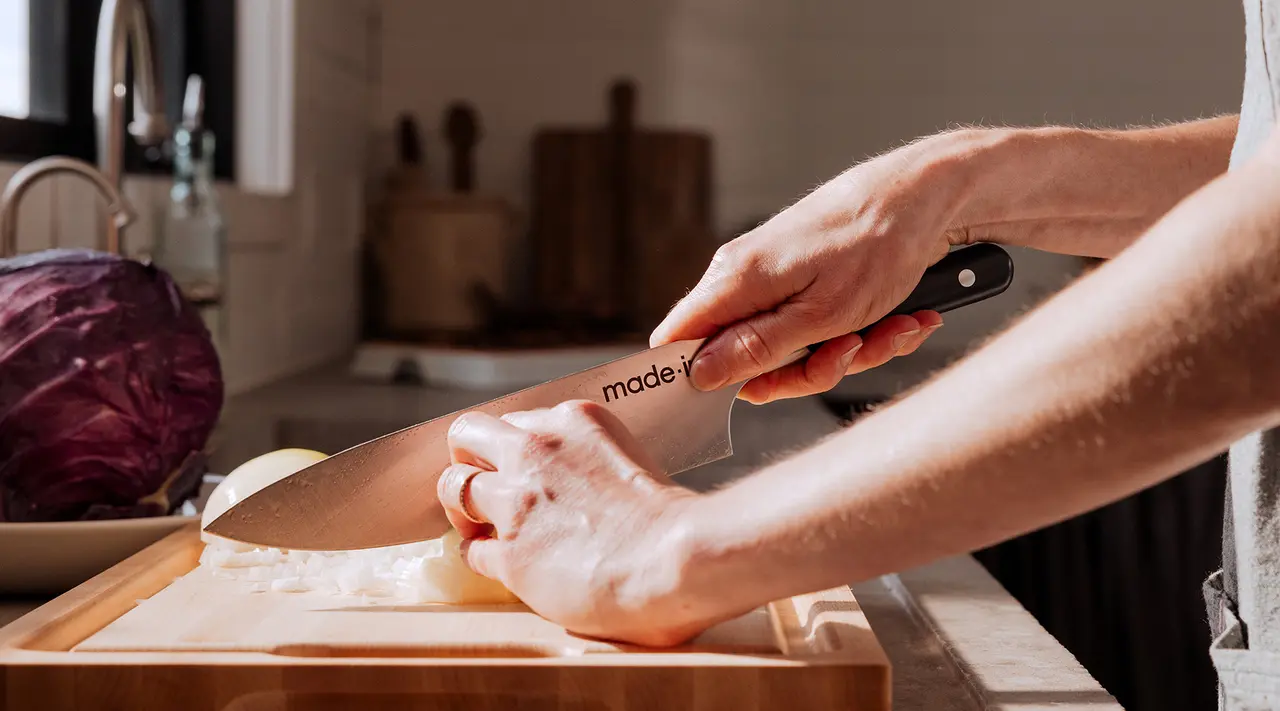We’ve all been there—you’re preparing dinner, and as you go to cut your ingredient, the knife slips, and that sharp blade nicks you on the hand. You have to stop everything you’re doing, wash your cut, and then you have to prepare the rest of your meal hindered and injured.
While avoiding kitchen accidents may not be 100% foolproof (accidents always happen), you'll still feel safe and comfortable when wielding a kitchen knife with these 7 knife safety tips.
Start With the Right Knives
Before we dive into knife safety tips, it is important to make sure you have the right knives. First, having an assortment is critical to making precise cuts. A Chef’s Knife, a vegetable knife like a Santoku or Nakiri, a Bread Knife, and a Paring Knife are essentials.
Fully forged and full tang knives are ideal, as they are incredibly durable and strong. They are forged from one piece of high-quality steel, resulting in an extraordinarily balanced and comfortable feel. Knowing how to hold a chef knife, or any other type of kitchen knife, is also important when considering safety.
Keep Your Knives Sharp
You’ve most likely heard the saying, “a dull knife is a dangerous knife,” and that statement is true and a wise one to live by when handling kitchen knives. If you have a dull blade, it will not make that initial cut. The blade may slip away and lose control. This immediately puts your hand and any other things in your cutting path in danger, and underlines the importance of keeping your knife sharpened.
Use the Right Technique
How you hold your knife when cutting is an important step to ensure optimal safety. We recommend the "claw clip."
When cutting and prepping ingredients, use your non-cutting hand to grip the ingredient with a claw. That means bending the top third of your fingers and either resting your nails on the food or the whole top third on the food, allowing your middle third of the finger to create a wall.
This wall can guide the sharp knife, as long as when you are slicing, the bottom of the blade doesn’t come above that part of the finger. If you’re new to cutting and slicing ingredients, then go slowly, and work your way up to a speed where you are comfortable.
Keep Your Cutting Space Clear
Another safety tip is to work with a clean cutting board and cutting area. If you have a bunch of ingredients, a wine glass, and some containers on your work surface, a slip of a kitchen knife can cause quite a disaster. You should only keep the ingredient you’re slicing on the cutting board.
We recommend utilizing Sheet Pans. Having one sheet pan with your ingredients and another sheet pan to hold the ingredients you’ve prepped is a great way to keep your kitchen organized, clean, and most importantly, protect you from any accidents.
Choose the Right Knife for the Right Job
There’s a reason there are many different types of kitchen knives. Each knife has a unique purpose and excels at cutting different ingredients. Based on the length, blade shape, and makeup, you should avoid using some knives with specific ingredients.
- Serrated Knives, or Bread Knives: these are perfect for ingredients with soft insides and delicate or crust exteriors, like tomatoes or breads. Because of its serrated edge, it’s also one of the best knives for cutting meat. The blade’s teeth can latch onto the surface and create that initial cut cleanly without ruining the interior. When cutting with a bread knife, you want to move the blade back and forth, similar to how you would use a saw (let’s face it, a bread knife is just a miniature saw). Therefore, you wouldn’t want to use a bread knife when cutting onions, slicing carrots, or mincing garlic.
- Chef Knife, Santoku Knife, or Nakiri Knife: these are an excellent choice for most ingredients, but the smaller, more nimble cuts should be done by paring knife. For example, if you’re cutting strawberries, slicing grapes, or working with oddly shaped ingredients, using a paring knife will give you more control.
Dry Your Produce and Ingredients
This knife safety tip might be overlooked, but it is definitely important. It really only pertains to produce since that’s the only ingredient you would be washing before using.
Fruits and vegetables can be slippery, especially when they are still wet. Making sure all your produce is dry before you cut into them is a fantastic way to prevent any knife accidents. Moisture can cause your knife to slip, which is never a good thing, so make sure to take the extra 30-45 seconds to dry all of your ingredients with a clean towel.
Cut on the Right Surface
Using a cutting board is extremely important when using a knife, as it will keep the blade’s sharpness intact. We know it’s convenient to just cut an apple on your countertop, but this will dull your knife’s edge and can ruin your countertop.
Small kitchen tasks like hulling strawberries, trimming green beans, or peeling fruits and vegetables can be completed with the ingredient in one hand and the knife blade in the other. If you feel comfortable performing this task, then go ahead! Just make sure to be aware of your hand and finger placement.
Overall, your safety in the kitchen is the most important. Make sure you’re confident in handling each and every knife from your knife set to avoid any major accidents. Once you do, you’ll be able to slice and dice just about anything.























